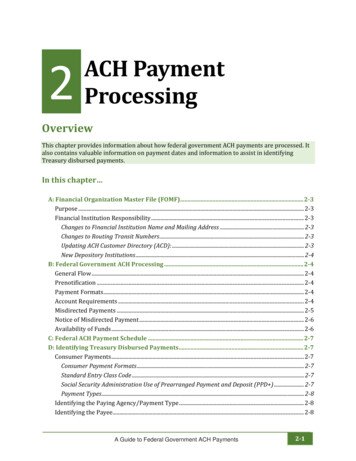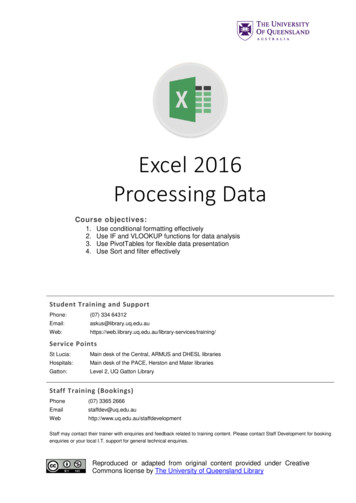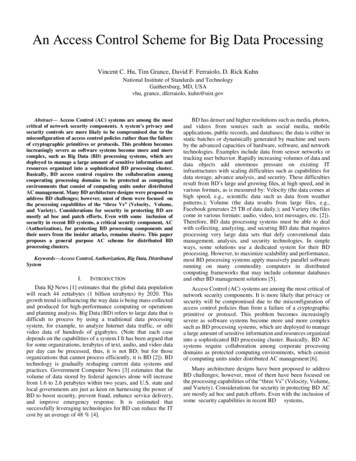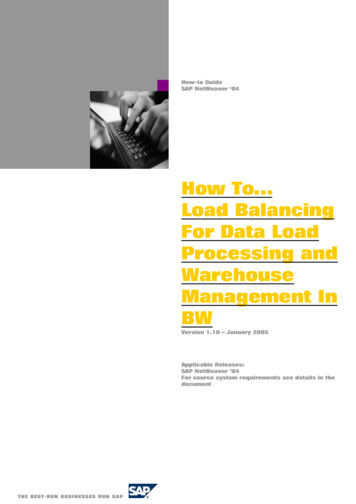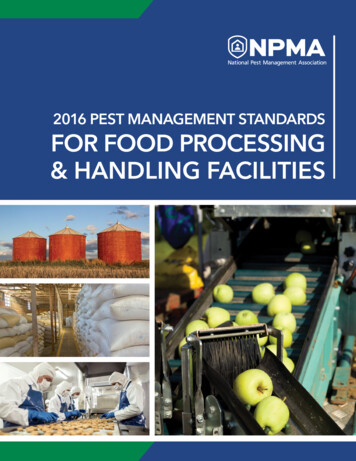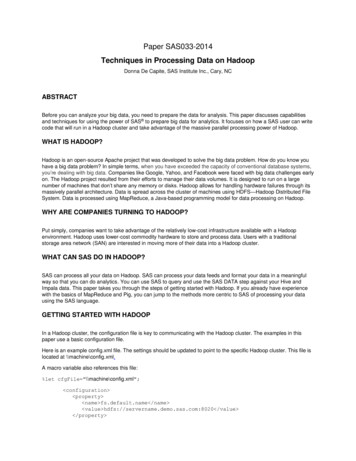
Transcription
Paper SAS033-2014Techniques in Processing Data on HadoopDonna De Capite, SAS Institute Inc., Cary, NCABSTRACTBefore you can analyze your big data, you need to prepare the data for analysis. This paper discusses capabilitiesand techniques for using the power of SAS to prepare big data for analytics. It focuses on how a SAS user can writecode that will run in a Hadoop cluster and take advantage of the massive parallel processing power of Hadoop.WHAT IS HADOOP?Hadoop is an open-source Apache project that was developed to solve the big data problem. How do you know youhave a big data problem? In simple terms, when you have exceeded the capacity of conventional database systems,you’re dealing with big data. Companies like Google, Yahoo, and Facebook were faced with big data challenges earlyon. The Hadoop project resulted from their efforts to manage their data volumes. It is designed to run on a largenumber of machines that don’t share any memory or disks. Hadoop allows for handling hardware failures through itsmassively parallel architecture. Data is spread across the cluster of machines using HDFS—Hadoop Distributed FileSystem. Data is processed using MapReduce, a Java-based programming model for data processing on Hadoop.WHY ARE COMPANIES TURNING TO HADOOP?Put simply, companies want to take advantage of the relatively low-cost infrastructure available with a Hadoopenvironment. Hadoop uses lower-cost commodity hardware to store and process data. Users with a traditionalstorage area network (SAN) are interested in moving more of their data into a Hadoop cluster.WHAT CAN SAS DO IN HADOOP?SAS can process all your data on Hadoop. SAS can process your data feeds and format your data in a meaningfulway so that you can do analytics. You can use SAS to query and use the SAS DATA step against your Hive andImpala data. This paper takes you through the steps of getting started with Hadoop. If you already have experiencewith the basics of MapReduce and Pig, you can jump to the methods more centric to SAS of processing your datausing the SAS language.GETTING STARTED WITH HADOOPIn a Hadoop cluster, the configuration file is key to communicating with the Hadoop cluster. The examples in thispaper use a basic configuration file.Here is an example config.xml file. The settings should be updated to point to the specific Hadoop cluster. This file islocated at \\machine\config.xml.A macro variable also references this file:%let cfgFile "\\machine\config.xml"; configuration property name fs.default.name /name value hdfs://servername.demo.sas.com:8020 /value /property
property name mapred.job.tracker /name value servername.demo.sas.com:8021 /value /property /configuration HELLO WORLD!The “Hello World” of Hadoop is working with the Shakespeare examples on the Apache Hadoop pages. Here’s anexample to get started with using SAS to process this data. In this example, the Shakespeare data is moved toc:\public\tmp.The first thing that you need to do is to land your Shakespeare data out on your cluster. There is always more thanone way to do things, so this is not an exhaustive list of techniques. The file system for Hadoop is called the HadoopDistributed File System (HDFS). Data needs to be in HDFS to be processed by Hadoop.MOVING DATA TO ******** Simple example of moving a file to HDFS** filename to Hadoop cluster *****************/filename cfg “\\machine\config.xml";;/* create authdomain in SAS Metadata named "HADOOP" ** copy file from my local file system to HDFS** HDFS location is *************/proc hadoop options cfg authdomain ”HADOOP” verbose;hdfs copyfromlocal ”c:\public\tmp\hamlet.txt”out "/user/sas/hamlet.txt" overwrite;run;The AUTHDOMAIN option is used. If you have set up AUTHDOMAIN, then you do not need to specify USERNAME and PASSWORD .Once the data is in HDFS, you will want to read that data and process it in Hadoop to take advantage of the parallelprocessing power of Hadoop.RUNNING MAPREDUCE IN A HADOOP CLUSTER FROM SASPROC HADOOP can submit the sample MapReduce program that is shipped with Hadoop via the following SAScode:proc hadoopoptions cfg verboseAuthDomain "HADOOP";hdfs delete "/user/sas/outputs";mapreduceinput "/user/sas/hamlet.txt"output "/user/sas/outputs"jar "C:\Public\tmp\wcount.jar"map "org.apache.hadoop.examples.WordCount TokenizerMapper"reduce "org.apache.hadoop.examples.WordCount IntSumReducer"combine "org.apache.hadoop.examples.WordCount IntSumReducer"outputvalue "org.apache.hadoop.io.IntWritable"outputkey "org.apache.hadoop.io.Text"
;run;RUNNING PIG IN A HADOOP CLUSTER FROM SASApache Pig is another technique available to Hadoop users for the simple processing of data. This example does aword count using Pig Latin:filename W2A8SBAK temp ;data null ;file W2A8SBAK;put "A load '/user/sas/hamlet.txt'; ";put "B foreach A generate flatten(TOKENIZE((chararray) 0)) as word; ";put "C Filter B by (word matches 'The');";put "D group C by word;";put "E foreach D generate COUNT(C), group;";put "F store E into '/user/sas/pig theCount';";run;proc hadoopoptions cfg verboseAuthDomain "HADOOP";pig code W2A8SBAK;run;The output file is writing in HDFS and shows the words and their occurrences in the source data. You can look at theHadoop log files to see how many mappers and reducers were run on the data.USING HDFS TO STORE SAS DATA SETSWhat if you have already have SAS data and want to take advantage of the commodity hardware capabilities of yourHadoop cluster? In other words, use HDFS for the storage of your SAS data and run SAS against that data. SASuses its distributed data storage format with the SAS Scalable Performance Data (SPDE) Engine for Hadoop. In theexample below, you can move your SAS data set to HDFS and use SAS to work with that data. Currently, theprocessing of the data does not take place using MapReduce. This functionality uses HDFS. SAS ScalablePerformance Data Engine (SPDE) provides parallel access to partitioned data files from the SAS client.libname testdata spde '/user/dodeca' hdfshost default;libname cars base '\\sash\cardata';proc copy in cars out testdata;select cardata;run;RUNNING SAS AGAINST YOUR HADOOP DATAproc freq data testdata.Cardata;tables Color;run;
Figure 1. Results from PROC FREQACCESSING HIVE DATA USING SAS/ACCESS INTERFACE TO HADOOPSAS/ACCESS Interface to Hadoop provides a LIBNAME engine to get to your Hadoop Hive data. Below is a simpleexample using PROC SQL:/* CTAS – create table as select */proc sql;connect to hadoop (server duped user myUserID);execute (create table myUserID store cntrow format delimited fields terminated by '\001'stored as textfileasselect customer rk, count(*) as total ordersfrom order factgroup by customer rk) by hadoop;disconnect from hadoop;quit;/* simple libname statement */libname myhdp hadoop server duped user myUserID ;/* Create a SAS data set from Hadoop data */proc sql;create table work.join test as (select c.customer rk, o.store idfrom myhdp.customer dim c, myhdp.order fact owhere c.customer rk o.customer rk);
quit;Below is a PROC FREQ example. The Hadoop LIBNAME exposes standard SAS functionality such as PROC FREQagainst Hadoop data./* PROC FREQ example*//*Create a Hive table */data myhdp.myUserID class;set sashelp.class;run;/* Run PROC FREQ on the class table */proc freq data myhdp.myUserID class;tables sex * age;where age 9;title 'Frequency';run;LEVERAGING THE POWER OF SAS TO PROCESS YOUR HADOOP DATA ACROSS THE CLUSTERIn this example, SAS Enterprise Miner is used to develop a model for scoring. The result is a score.sas and score.xmlfiles. This functionality can be deployed to a Hadoop cluster for all of the processing to take place in Hadoop.To run scoring in Hadoop, there are several prerequisites to processing the data. Metadata needs to be known aboutthe input data. The PROC HDMD can be used to register this metadata. Credentials must be provided to connect tothe Hadoop cluster using the INDCONN macro variable.Scoring Accelerator for HadoopSAS Enterprise Miner can be used to build models. Using the Score Export node from SAS Enterprise Miner, thescoring code can be exported for scoring to take place on your Hadoop cluster. The code below sets up theconnection to the cluster, it publishes the scoring code to HDFS, and it then runs the model.%let%let%let%let%letmodelnm AL32;scorepath C:\Public\Hadoop\Sample Files\ALL\AL32;metadir %str(/user/hadoop/meta);ds2dir %str(/user/hadoop/ds2);INDCONN %str(HADOOP CFG &configUSER &user PASSWORD &pw);%indhd publish model(,,,,,,dir &scorepath.datastep score.sas.xml score.xml.modeldir &ds2dir.modelname &modelnm.action replacetrace yes);%indhd run model(inmetaname &metadir./al32.sashdmd, outdatadir &datadir./&modelnm.out, outmetadir &metadir./&modelnm.out.sashdmd, scorepgm &ds2dir./&modelnm./&modelnm.ds2, forceoverwrite false, showproc yes /* showproc and trace are debug options */, trace yes);/* Select the values from the scoring results on Hadoop*/proc sql;
select em classification from gridlib.&modelnm.out;quit;At this point, the scoring algorithm runs through all of the data and provides a score for the data. The processing alltakes place in Hadoop. The SAS term “in-database” is a carry-over term from the days of putting the processingpower of SAS into databases. SAS embeds the process into the Hadoop cluster so that the cluster does all the work.There is no data movement back to SAS.SAS provides the ability to embed user-written code into Hadoop. That functionality is provided through the SASCode Accelerator for Hadoop. This functionality is currently in development and is due to be released in the summerof 2014.RUNNING USER-WRITTEN SAS CODEThe SAS embedded process technology offers the ability for a user to run SAS code in the cluster and takeadvantage of the processing power of Hadoop. The first offering from SAS was the SAS Scoring Accelerator forHadoop. The next offering from SAS (target release date around summer 2014) is the SAS Code Accelerator forHadoop.Code AcceleratorThe example below takes data and spreads it across the cluster using BY-group processing and uses first/last dotnotation to output the result. This technique takes advantage of Hadoop processing power to do all of the calculationsin the mapper stage.libname hdptgt hadoop server &server port 10000 schema sample user hive password hiveconfig "&hadoop config file";proc ds2 indb yes;thread tpgm / overwrite yes;declare double highscore;keep gender highscore;retain highscore;method run();set hdptgt.myinputtable;by gender;if first.gender then highscore 0;if score1 100 and score1 highscore then highscore score1;if last.gender then output;end;endthread;run;ds2 options trace;data hdptgt.myoutputscore(overwrite yes);dcl thread tpgm tdata;method run();set from tdata;end;enddata;run;quit;
Figure 2. Result from the SAS Code Accelerator ProgramPROCESSING FILES ON HADOOP TO LOAD SAS LASR ANALYTIC SERVERThe HDMD procedure enables you to register metadata about your HDFS files on Hadoop so that they can be easilyprocessed using SAS.The example below uses the Hadoop engine to parallel load your file data into the SAS LASR Analytic Server. Thissame technique can be used whenever you are working with Hadoop file data./* The HADOOP libname points to your Hadoop cluster */libname hdp HADOOP/* connection options */config &cfgFilehdfs datadir '/user/demo/files'hdfs tempdir '/user/demo/tmp'hdfs metadir '/user/demo/meta'hdfs permdir '/user/demo/perm';/* Start up a LASR Analytic Server on port 1314 */options set GRIDHOST "servername.demo.sas.com";options set GRIDINSTALLLOC "/opt/TKGrid";proc lasr create port 1314path "/tmp" noclass;performance nodes all;run;/* Use proc HDMD to create a definition of the movies.txt file – delimited by comma *//* This proc does not read the data, it just defines the structure of the data */Proc HDMD name hdp.moviesformat delimited encoding utf8sep ',' text qualifier '"'DATA FILE 'movies.txt'input format 'org.apache.hadoop.mapred.TextInputFormat';column userID int;column itemId int;column rating int;column timeID int;run;/* Now load the data into the LASR Analytic Server *//* Parallel load of movies data into LASR */proc lasr add port 1314data hdp.movies; run;/* terminate the lasr server @ port 1314 */proc lasr term port 1314; run;SAS DATA DIRECTOR
The SAS Data Director (target release date around summer 2014) is a visual client that allows for processing Hadoopdata on the cluster. It provides a point-and-click interface that makes it easy to work with Hadoop data. SAS DataDirector is a code generator. Depending on the type of transformation required, different code generation techniquesare used. SAS Data Director uses native MapReduce, SAS Code Accelerator for DS2, SAS/ACCESS Interface toHadoop for Hive queries and Apache Sqoop. Below are a few examples of the type of processing provided by SASData Director.Sqoop Data In and Out of HadoopUsing SAS Data Director, the user selects the location of the data to copy and the target location. A fast parallel loadis then initiated to copy the data from the relational database into Hadoop.Figure 3. SAS Data Director Copies Data to Hadoop Using SqoopSAS Data Director transforms the data on your Hadoop cluster (using filter, subset, join, and sort).
Figure 4. Example of SAS Data Director Transforming Data in HadoopEasy Movement of Data to SAS LASR Analytic Server and SAS Visual Analytics ServerParallel loads into SAS LASR Analytic Server and SAS Visual Analytics Server are easy with SAS Data Director.Specify the source and the LASR target and data is copied into SAS LASR Analytic Server.Figure 5. Example of SAS Data Director Copying Hadoop Data to SAS LASR Analytic Server
HELPFUL TECHNIQUES TO WORK WITH HADOOP DATAThe HDFS housekeeping routines that are provided by PROC HADOOP are handy to verify that the directorystructure is in place or that old data is cleared out before running your SAS Hadoop job.When preparing my Hadoop environment for scoring, I relied on PROC HADOOP to get my directory structure inplace.proc hadoopoptions "\\sashq\root\u\sasdsv\dev\Hadoop\cdh431d1 config\core-site.xml"USER "&dbuser" PASSWORD "&dbpw";hdfs mkdir "/user/dodeca/meta";hdfs mkdir "/user/dodeca/temp";hdfs mkdir "/user/dodeca/ds2";hdfs copyFromLocal "c:\public\scoring.csv"out "/user/dodeca/data/scoring.csv";run;CONCLUSIONSAS continues to provide more features for processing data in the Hadoop landscape. Most recently, SAS can takeadvantage of the processing power of Hadoop with its embedded process technology. SAS will continue to offer morefeatures as the Hadoop ecosystem delivers more functionality. For example, SAS/ACCESS Interface to Impala wasreleased in early 2014.RECOMMENDED READING Secosky, Jason, et al. 2014. “Parallel Data Preparation with the DS2 Programming Language.” Proceedings ofthe SAS Global Forum 2014 Conference. Cary, NC: SAS Institute Inc. Available ngs14/SAS329-2014.pdf. Rausch, Nancy, et al. 2014. “What’s New in SAS Data Management.” Proceedings of the SAS Global Forum2014 Conference. Cary, NC: SAS Institute Inc. Available ngs14/SAS034-2014.pdf. Rausch, Nancy, et al. 2013. “Best Practices in SAS Data Management for Big Data.” Proceedings of the SASGlobal Forum 2013 Conference. Cary, NC: SAS Institute Inc. Available ngs13/077-2013.pdf.CONTACT INFORMATIONYour comments and questions are valued and encouraged. Contact the author at:Donna De Capite100 Campus DriveCary, NC 27513SAS Institute Inc.Work Phone: (919) 677-8000Fax: (919) 677-4444E-mail: Donna.DeCapite@sas.comWeb: support.sas.com
SAS and all other SAS Institute Inc. product or service names are registered trademarks or trademarks of SASInstitute Inc. in the USA and other countries. indicates USA registration.Other brand and product names are trademarks of their respective companies.
In this example, SAS Enterprise Miner is used to develop a model for scoring. The result is a score.sas and score.xml files. This functionality can be deployed to a Hadoop cluster for all of the processing to take place in Hadoop. . processed using SAS. The example below uses the Hadoop eng
